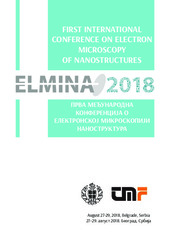| dc.description.abstract | Regarding their extraordinary properties, such as biological and chemical sta-
bility, photocatalytic activity, cost-effectiveness, the titanium-based nanoma-
terials are the subject of an intense research. Although titania is well known
as a photocatalyst, the titanates are promising candidates for the wide range
of applications including ion exchange, high adsorption capacity toward or-
ganic molecules and radioactive toxic metal ions[2], in photovoltaics, H- and
Li-storage, gas sensors, etc. The hydrothermal process became a very import-
ant way to obtain these materials in nanostructural form since the discovery of
anatase-based alkaline hydrothermal treatment reported by Kasuga et al. [1].
In this work, nine products were obtained by modifying the experimental conditions
(6, 12 and 18 h at 110, 135 and 160 °C) of hydrothermal treatment of starting nano-
anatase in less alkaline medium (5 mol dm–3 NaOH solution) than usual. Specimens
are labeled as TT–t, where T is temperature of the treatment and t is duration of the
treatment. The step-by-step optimization of this simple and costless procedure was
necessary in order to obtain a pure titanate phase and to finally distinguish the ti-
tanates from titania in terms of structure and microstructure. The nanocrystalline
samples were characterized by HRTEM/SAED, XRPD, EDS, TG, UV-VIS and BET
techniques.According to XRPD and HRTEM, the complete conversion of anatase to pure
titanate phase was achieved after energetically the most intensive treatment, i.e.
18 h at 160 °C. Among other products, a certain amount of anatase remained,
with its decreasing content as the temperature and time of hydrothermal treatment
increases. This increment significantly improves the solubility of TiO2 promoting the
changes in morphology from the approximately spherical anatase nanoparticles into
elongated titanate nanosheets (Fig. 1). Based on EDS and TG, the Na0.4H1.6Ti2O5·H2O
formula could be assigned to T160_18. The HRTEM/SAED revealed the shortening of
interplanar distances along aaxis because of the dehydratation due to the high vacuum
of the TEM chamber and high energy of the electron beam irradiation confirming the
layered structure of Na0.4H1.6Ti2O5·H2O (Fig. 2). Because of the poor characterization
of titanate nanosheets found in literature, the optical and textural properties of
products were also investigated. A blue shift toward lower wavelength is observed
with the temperature increasing being the most pronounced for the T160_18 (Fig. 3).
This is the consequence of full transformation of TiO2 into Na0.4H1.6Ti2O5·H2O. For
the same reason, the values of specific surface areas decreased with the temperature
increasing.
As shown in this work, the structure, morphology and texture of samples strongly
depend of the conditions of hydrothermal treatment. The production of single phase
titanate and its detailed microscopic characterization finally allowed the clarification
of long-standing confusion between titania and titanates.
References:
[1] T Kasuga et al, Langmuir 14 (1998), p. 3160.
[2] Y Zhang et al, RSC Advances 5 (2015), p. 79479.
[3] The authors acknowledge funding from the Ministry of Education, Science and
Technological Development of the Republic of Serbia, Grant Numbers III45007
and III45019. The support of the bilateral cooperation with Slovenia is also
gratefully acknowledged (Project No. 451-03-3095/2014-09/32). | sr |

